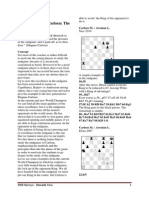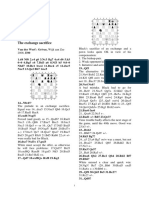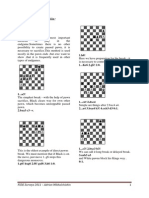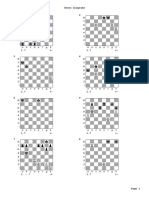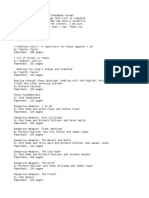Illescas - Fools Mate
Illescas - Fools Mate
Uploaded by
pavel_janda_3Copyright:
Available Formats
Illescas - Fools Mate
Illescas - Fools Mate
Uploaded by
pavel_janda_3Original Description:
Copyright
Available Formats
Share this document
Did you find this document useful?
Is this content inappropriate?
Copyright:
Available Formats
Illescas - Fools Mate
Illescas - Fools Mate
Uploaded by
pavel_janda_3Copyright:
Available Formats
Miguel Illescas: Fool's Mate
Knowledge of the basic mate structures is essential to improve your play. This article is intended to help players in the range 1600-2200 elo rating. One of the best known mates which at the same time is one of the less appreciated is the Fool's mate. Every beginner learns this mate when he starts to play chess. The reason behind the name becomes quite clear when we realize how it appears on the board: 1.f3? e5 2.g4?? Dh4# XIIIIIIIIY 9rsnl+kvlntr0 9zppzpp+pzpp0 9-+-+-+-+0 9+-+-zp-+-0 9-+-+-+Pwq0 9+-+-+P+-0 9PzPPzPP+-zP0 9tRNvLQmKLsNR0 xiiiiiiiiy White has weakened the e1-h4 diagonal decisively and immediately receives his punishment. Of course, this is the fastest check mate in a chess game, and therefore White must certainly be quite mad to allow his position to collapse in only two moves. In fact, in my 5-million game database, I have only found four games with this sequence of moves, so one could easily question the practical utility of knowing this mate. However, experience shows us that chess knowledge must never be underestimated. Let's take a look at a game I played against the great champion Gary Kasparov: Dutch Defence 1.d4 f5 2.Lg5 h6 3.Lh4 g5 4.Lg3 XIIIIIIIIY 9rsnlwqkvlntr0 9zppzppzp-+-0 9-+-+-+-zp0 9+-+-+pzp-0 9-+-zP-+-+0 9+-+-+-vL-0 9PzPP+PzPPzP0 9tRN+QmKLsNR0 xiiiiiiiiy FIDE SURVEYS Miguel Illescas
It seems that White has allowed his bishop to be shut in. Of the 244 games that arrived at this position, in none less than 18 Black was too ambitious and fell straight into the following wellknown opening trap: 4...f4? 5.e3! fg3?? 6.Dh5 mate XIIIIIIIIY 9rsnlwqkvlntr0 9zppzppzp-+-0 9-+-+-+-zp0 9+-+-+-zpQ0 9-+-zP-+-+0 9+-+-zP-zp-0 9PzPP+-zPPzP0 9tRN+-mKLsNR0 xiiiiiiiiy And here we have it: the Fool's Mate. By the way, two of the games in my database ended in mate. Of course in the other two games Black played 5...Sf6 but after 6.ef4 White has already won a pawn. The correct continuation is to defend the mate with 4...Sf6 5.e3 d6 as in Kasparov-Illescas, Dos Hermanas 1996, which finished in 52 moves. There are other cases in which an oversight can lead to a quick Fool's ending: Bird Opening 1.f4 e5!? 2.fe5 d6 3.ed6 Ld6 XIIIIIIIIY 9rsnlwqk+ntr0 9zppzp-+pzpp0 9-+-vl-+-+0 9+-+-+-+-0 9-+-+-+-+0 9+-+-+-+-0 9PzPPzPP+PzP0 9tRNvLQmKLsNR0 xiiiiiiiiy The From gambit, clearly the most aggressive line against the Bird. Black's threat is so obvious that White missed it in only 1 out of 1.650 games: 4.Sc3?? Dh4 5.g3 Lg3 XIIIIIIIIY 9rsnl+k+ntr0 9zppzp-+pzpp0 9-+-+-+-+0 9+-+-+-+-0 9-+-+-+-wq0 9+-sN-+-vl-0 9PzPPzPP+-zP0 9tR-vLQmKLsNR0 xiiiiiiiiy Personally, I would have captured on g3 with the queen but in any case White resigned. Naturally, the
1
correct move was 4.Sf3, protecting the vital h4 square, after which Black obtains good compensation in exchange for the sacrificed pawn, both, in the aggressive 4...g5, as in the slow 4...Sf6 or 4...Lg4 variations. Generally, when the queen gets to h5 (or h4 for Black) the attack becomes very strong. I recall a theoretical discussion from my junior years: Owen Defence 1.e4 b6 2.d4 Lb7 3.Ld3 f5? XIIIIIIIIY 9rsn-wqkvlntr0 9zplzppzp-zpp0 9-zp-+-+-+0 9+-+-+p+-0 9-+-zPP+-+0 9+-+L+-+-0 9PzPP+-zPPzP0 9tRNvLQmK-sNR0 xiiiiiiiiy This reckless move is currently considered to be refuted but years ago the assessment wasn't so clear and we can find 109 games in the database. Nowadays, theory has established that the modest 3...e6 is much better. 4.ef5! Surprisingly, White only plays this energetic move that sacrifices his rook on h1, in 63 games. The following moves are forced. 4...Lg2 5.Dh5 g6 6.fg6 Lg7! There are four games with 6...Sf6? 7.gh7 Sh5 8.Lg6# including one published in Greco's 1620 book and a more recent one played in 2009; 389 years later the Fool's mate makes a comeback! XIIIIIIIIY 9rsn-wqkvl-tr0 9zp-zppzp-+P0 9-zp-+-+L+0 9+-+-+-+n0 9-+-zP-+-+0 9+-+-+-+-0 9PzPP+-zPlzP0 9tRNvL-mK-sNR0 xiiiiiiiiy Let's return to the main line. We can see that in spite of Black's ingenious defense, White's attack quickly becomes devastating: 7.gh7 Kf8
XIIIIIIIIY 9rsn-wq-mkntr0 9zp-zppzp-vlP0 9-zp-+-+-+0 9+-+-+-+Q0 9-+-zP-+-+0 9+-+L+-+-0 9PzPP+-zPlzP0 9tRNvL-mK-sNR0 xiiiiiiiiy Black hopes that after 8.hg8D Kg8 9.Dg4 Lh1 the compensation for the exchange will be insufficient, but White has a much stronger reply. 8.Sf3! The knight joins the attack without paying attention to the smaller details, such as the rook that is now being sacrificed. Certainly, after 8...Lh1 9.Se5 Le5 10.de5, with the idea Lh6, White will mate quickly. Therefore, first Black brings his knight into play. 8...Sf6 9.Dg6! XIIIIIIIIY 9rsn-wq-mk-tr0 9zp-zppzp-vlP0 9-zp-+-snQ+0 9+-+-+-+-0 9-+-zP-+-+0 9+-+L+N+-0 9PzPP+-zPlzP0 9tRNvL-mK-+R0 xiiiiiiiiy And now the black bishop must choose the piece it prefers to capture. If it captures the knight, the rook that we had left dying joins the attack via g1, for example: 9...Lf3 10.Tg1 Th7 11.Dg3, and White recovers the material by force, and has a better position: 11...Le4 12.Le4 Se4 13.Df3 Kg8 14.De4 Sc6 15.d5 Sa5 16.Sc3, with a huge advantage. Therefore, finally Black has to act in a consequent way and capture the rook but he will soon find himself in a mating net. 9...Lh1 10.Lh6! Th7 If 10...Lh6 11.Dh6 Kf7 12.Sg5 Ke8 13.Lg6 mate. 11.Sg5! XIIIIIIIIY 9rsn-wq-mk-+0 9zp-zppzp-vlr0 9-zp-+-snQvL0 9+-+-+-sN-0 9-+-zP-+-+0 9+-+L+-+-0 9PzPP+-zP-zP0 9tRN+-mK-+l0 xiiiiiiiiy The following sequence is forced.
2
FIDE SURVEYS Miguel Illescas
11...Lh6 12.Sh7 Sh7 13.Dh6 Kf7 14.Dh7 Ke6 15.Dg6 Kd5 16.Sc3 Kd4 17.Dg5 XIIIIIIIIY 9rsn-wq-+-+0 9zp-zppzp-+-0 9-zp-+-+-+0 9+-+-+-wQ-0 9-+-mk-+-+0 9+-sNL+-+-0 9PzPP+-zP-zP0 9tR-+-mK-+l0 xiiiiiiiiy and obviously with his king stranded in the center Black receives mate on the next move. After considering the previous examples we might think that the ideas derived from the Fool's Mate can only be applied in marginal opening lines but this is not true. Let us transport ourselves to an emblematic city, Linares, with two world class Grand Masters and one of the most solid and respectable openings, the Caro-Kahn. The Fool's Mate decided to make an appearance in such a magnificent event: Caro-Kann Defence Nunn J. : Georgiev K. Linares 1988 1.e4 c6 2.d4 d5 3.Sc3 de4 4.Se4 Sd7 Black prepares the development of the other knight avoiding the doubled pawns that would arise after 4...Sf6 5.Sf6. 5.Sg5!? An interesting idea that became popular precisely in the eighties. White plans ahead of his opponent and makes it clear that he doesn't want an exchange of knights. Also, moving to g5 hinders the development of the c8 bishop, as the attack on f7 will force Black to advance his pawn to e6. 5...h6? XIIIIIIIIY 9r+lwqkvlntr0 9zpp+nzppzp-0 9-+p+-+-zp0 9+-+-+-sN-0 9-+-zP-+-+0 9+-+-+-+-0 9PzPP+-zPPzP0 9tR-vLQmKLsNR0 xiiiiiiiiy It is highly probable that Georgiev missed his FIDE SURVEYS Miguel Illescas
opponent's reply. Normal development was correct, for example 5...Sgf6. Now White plays a nice move, under the shadow of the Fool's Mate. 6.Se6! XIIIIIIIIY 9r+lwqkvlntr0 9zpp+nzppzp-0 9-+p+N+-zp0 9+-+-+-+-0 9-+-zP-+-+0 9+-+-+-+-0 9PzPP+-zPPzP0 9tR-vLQmKLsNR0 xiiiiiiiiy Here is the key. The knight can't be touched because of the mate on h5. 6...Da5? Mistakes come in pairs, as Black tries to justify his previous oversight. More sensible was 6...Db6, although after 7.Sf8 Kf8 White enjoys a comfortable advantage with his pair of bishops in an open position. 7.Ld2 Db6 Thanks to the check Black now attacks the d4 and b2 pawns, as well as the knight, but Nunn doesn't seem to be too worried and calmly continues his development. In his turn Georgiev, clearly affected by the course the game has taken, turns mad and decides to eliminate the enemy knight at a stroke, omitting an elemental reply. 8.Ld3!? fe6?? 9.Dh5! Kd8 10.La5! XIIIIIIIIY 9r+lmk-vlntr0 9zpp+nzp-zp-0 9-wqp+p+-zp0 9vL-+-+-+Q0 9-+-zP-+-+0 9+-+L+-+-0 9PzPP+-zPPzP0 9tR-+-mK-sNR0 xiiiiiiiiy Black has saved his King but lost his queen. An unbelievable ending to a top-level game Precisely 1988 was my first time playing in the great Linares tournament, so I was there when the battle-hardened Bulgarian, after putting up a useless resistance, finally resigned on move 42. After the round had finished, as the last players and spectators abandoned the playing hall, the Fool's happy laughter could still be heard behind the stage ...
You might also like
- Best Move Guide - LarsenDocument135 pagesBest Move Guide - LarsenMarcos Suran97% (36)
- Winning With The Modern London System 2 PDFDocument336 pagesWinning With The Modern London System 2 PDFRajnish Goel82% (11)
- Chess Tactics For Intermediates - Karthik PMDocument102 pagesChess Tactics For Intermediates - Karthik PMYoussef NabilNo ratings yet
- FIDE-TRG - 64 Chess Lessons - BookDocument104 pagesFIDE-TRG - 64 Chess Lessons - Bookpavel_janda_3100% (3)
- Herman SrebrenicaDocument301 pagesHerman SrebrenicaSerge Trifkovic100% (7)
- Playing Out From The Back - Session Plan & Coaching Points (2020 Edition)Document4 pagesPlaying Out From The Back - Session Plan & Coaching Points (2020 Edition)Rob Crisp100% (1)
- Puzzles - PetroffDocument13 pagesPuzzles - PetroffArman Siddique100% (1)
- Beliavsky & Mikhalchishin - Winning Endgame StrategyDocument207 pagesBeliavsky & Mikhalchishin - Winning Endgame StrategyRATHEESH P.K100% (6)
- Learning Chess Step4 SolutionsDocument15 pagesLearning Chess Step4 SolutionsZeynep Ciftci100% (6)
- Illescas - Lucenas MateDocument5 pagesIllescas - Lucenas Matepavel_janda_3No ratings yet
- Illescas - Lollis MateDocument7 pagesIllescas - Lollis MateRenukha PannalaNo ratings yet
- Jeroen Bosch - Rook and Pawn Versus Two Minor PiecesDocument12 pagesJeroen Bosch - Rook and Pawn Versus Two Minor Piecespavel_janda_3No ratings yet
- Illescas - Damianos MateDocument7 pagesIllescas - Damianos MateRenukha PannalaNo ratings yet
- Xiiiiiiiiy 9R+-+-Trk+0 9+P+-+-Zp-0 9-+Pzppwq-Zp0 9Zp-+-Zp-+-0 9P+-+P+-Sn0 9+-Zppsn-Zp-0 9-Zp-Snqsnkzp0 9Tr-+-+R+-0 XiiiiiiiiyDocument5 pagesXiiiiiiiiy 9R+-+-Trk+0 9+P+-+-Zp-0 9-+Pzppwq-Zp0 9Zp-+-Zp-+-0 9P+-+P+-Sn0 9+-Zppsn-Zp-0 9-Zp-Snqsnkzp0 9Tr-+-+R+-0 Xiiiiiiiiypavel_janda_3No ratings yet
- Viacheslav Eingorn - Rook Vs Bishop PDFDocument4 pagesViacheslav Eingorn - Rook Vs Bishop PDFzooloo150No ratings yet
- Fide June 2016 - PetrosyanDocument6 pagesFide June 2016 - PetrosyanMaestro JayNo ratings yet
- FIDE December 2015 - JansaDocument9 pagesFIDE December 2015 - JansaRenukha PannalaNo ratings yet
- FIDE Survey Feb 2013 - Adrian MikhachishinDocument12 pagesFIDE Survey Feb 2013 - Adrian MikhachishinRenukha Pannala100% (1)
- FIDE JUNE 2017 - Vladimir Grabinsky PDFDocument7 pagesFIDE JUNE 2017 - Vladimir Grabinsky PDFpavel_janda_3No ratings yet
- Georg Mohr - Outpost FIDE Trainers Survey 2014Document3 pagesGeorg Mohr - Outpost FIDE Trainers Survey 2014Renukha PannalaNo ratings yet
- Two Readers Endgame Blindfold TrainingDocument33 pagesTwo Readers Endgame Blindfold TrainingSatishAnAnnisNo ratings yet
- FIDE September - Dejan BojkovDocument5 pagesFIDE September - Dejan BojkovRenukha PannalaNo ratings yet
- Jeroen Bosch - Queen Power or Power of The MassesDocument7 pagesJeroen Bosch - Queen Power or Power of The Massespavel_janda_3No ratings yet
- Fide December 2017 - MohrDocument8 pagesFide December 2017 - MohrTux InoNo ratings yet
- FIDE Januar 2014 - VeraDocument6 pagesFIDE Januar 2014 - VeraGuruswami PrakashNo ratings yet
- Alexey Kuzmim - Training of Calculation IIDocument7 pagesAlexey Kuzmim - Training of Calculation IIpavel_janda_3No ratings yet
- FIDE Surveys - SKEMBRIS - JUNE 2015 PDFDocument5 pagesFIDE Surveys - SKEMBRIS - JUNE 2015 PDFRenukha PannalaNo ratings yet
- Oleksandr Sulypa: Stalemate in The Rook Endgames: Example 2Document6 pagesOleksandr Sulypa: Stalemate in The Rook Endgames: Example 2pavel_janda_3No ratings yet
- Uwe BNSCH - The Queens GambitDocument4 pagesUwe BNSCH - The Queens GambitRenukha PannalaNo ratings yet
- What Rooks WantDocument7 pagesWhat Rooks WantRenukha PannalaNo ratings yet
- Xiiiiiiiiy 9R+-+R+K+0 9Zplwqn+Pzp-0 9-Zppvlp+-Zp0 9+-+-+-+-0 9-+Pzp-+-+0 9+P+L+N+Q0 9Pvl-+-Zppzp0 9+-+Rtr-Mk-0 XiiiiiiiiyDocument8 pagesXiiiiiiiiy 9R+-+R+K+0 9Zplwqn+Pzp-0 9-Zppvlp+-Zp0 9+-+-+-+-0 9-+Pzp-+-+0 9+P+L+N+Q0 9Pvl-+-Zppzp0 9+-+Rtr-Mk-0 XiiiiiiiiyRenukha PannalaNo ratings yet
- Alexander Beliavsky - Reti From Black Perspective PDFDocument3 pagesAlexander Beliavsky - Reti From Black Perspective PDFCharles LucasNo ratings yet
- FIDE September - Vladimir Tukmakov PDFDocument9 pagesFIDE September - Vladimir Tukmakov PDFRenukha PannalaNo ratings yet
- Susan Polgar - Watch The QueenDocument5 pagesSusan Polgar - Watch The QueenRenukha PannalaNo ratings yet
- Jovan Petronic - The Magnificent SevenDocument7 pagesJovan Petronic - The Magnificent SevenRenukha PannalaNo ratings yet
- Fide March 2017 - BoschDocument10 pagesFide March 2017 - Boschpavel_janda_3No ratings yet
- Xiiiiiiiiy 9-+-+-+-+0 9+-Zpk+-+-0 9P+-+-+L+0 9+-+P+-+P0 9-+Pmk-Zp-+0 9+-Zp-+P+-0 9-+-+-+-Wq0 9Wq-+-+-+-0 XiiiiiiiiyDocument6 pagesXiiiiiiiiy 9-+-+-+-+0 9+-Zpk+-+-0 9P+-+-+L+0 9+-+P+-+P0 9-+Pmk-Zp-+0 9+-Zp-+P+-0 9-+-+-+-Wq0 9Wq-+-+-+-0 XiiiiiiiiyRenukha PannalaNo ratings yet
- Beliavsky - Queen Endings With An Extra PawnDocument6 pagesBeliavsky - Queen Endings With An Extra Pawnpavel_janda_3No ratings yet
- Vancura PositionDocument8 pagesVancura PositionotowasanNo ratings yet
- FIDE - PalatnikDocument4 pagesFIDE - PalatnikRenukha PannalaNo ratings yet
- 2012 GRIVAS - The King Out of The WayDocument7 pages2012 GRIVAS - The King Out of The Waypavel_janda_3No ratings yet
- Fide Survey March 2013 - MarinDocument5 pagesFide Survey March 2013 - MarinRenukha PannalaNo ratings yet
- Alexander Beliavsky - FIDE DECDocument13 pagesAlexander Beliavsky - FIDE DECRenukha PannalaNo ratings yet
- Challenging Black Counter Play in Maroczy StructuresDocument6 pagesChallenging Black Counter Play in Maroczy StructuresStans WoleNo ratings yet
- Books: David Delucia Collection Highlights of The Chess LibraryDocument49 pagesBooks: David Delucia Collection Highlights of The Chess LibraryIoannis GaroufalidisNo ratings yet
- Georg Mohr - Strategic PreventionDocument5 pagesGeorg Mohr - Strategic PreventionRenukha PannalaNo ratings yet
- FIDE March 2015 - Michael KhodarkovskyDocument5 pagesFIDE March 2015 - Michael KhodarkovskyRenukha PannalaNo ratings yet
- Efstratios Grivas - Middlegame Analysis PDFDocument21 pagesEfstratios Grivas - Middlegame Analysis PDFgdipesh01No ratings yet
- A Spanish Repertoire For Black: Update ToDocument25 pagesA Spanish Repertoire For Black: Update ToScribd AccountNo ratings yet
- FIDE - Sulypa - November 2014Document4 pagesFIDE - Sulypa - November 2014Renukha PannalaNo ratings yet
- Adrian Mikhachishin - BreakDocument7 pagesAdrian Mikhachishin - Breakpavel_janda_3No ratings yet
- FIDE October - Alojzije JankovicDocument5 pagesFIDE October - Alojzije JankovicRaja Ravi Kiran ReddyNo ratings yet
- Grivas January 1 2013Document8 pagesGrivas January 1 2013Renukha PannalaNo ratings yet
- Ruslan Sherbakov & Yuri Yakovich - WCC Candidate Matches 2007Document106 pagesRuslan Sherbakov & Yuri Yakovich - WCC Candidate Matches 2007truepotentialzNo ratings yet
- European Team Championship, Skara 1980Document88 pagesEuropean Team Championship, Skara 1980zeljko radivojevicNo ratings yet
- FIDE February - Adrian MikhalchisinDocument5 pagesFIDE February - Adrian MikhalchisinRenukha PannalaNo ratings yet
- FIDE November - DorfmanDocument4 pagesFIDE November - DorfmanRenukha PannalaNo ratings yet
- Xiiiiiiiiy 8R+-Wq-Tr-Mk0 7+L+-Vlpsnp0 6P+-Zp-Snpvl0 5+Pzppzp-+-0 4P+-+P+-+0 3+-Zp-Snn+P0 2-Zpl+-Zpp+0 1Tr-+Qtr-Mk-0 XabcdefghyDocument7 pagesXiiiiiiiiy 8R+-Wq-Tr-Mk0 7+L+-Vlpsnp0 6P+-Zp-Snpvl0 5+Pzppzp-+-0 4P+-+P+-+0 3+-Zp-Snn+P0 2-Zpl+-Zpp+0 1Tr-+Qtr-Mk-0 Xabcdefghyanmikkim100% (1)
- World Championship Starts To Warm Up: What's Hot and What's Not?Document4 pagesWorld Championship Starts To Warm Up: What's Hot and What's Not?honi23No ratings yet
- ICS Centre DynamicDocument18 pagesICS Centre DynamicsubashNo ratings yet
- Dvoretsky 126Document7 pagesDvoretsky 126mjhermanNo ratings yet
- FIDE Januar 2014 - GrivasDocument7 pagesFIDE Januar 2014 - GrivasGuruswami PrakashNo ratings yet
- Chess Today Magazine Compi PDFDocument1,911 pagesChess Today Magazine Compi PDFFrancoise EithssenNo ratings yet
- Rook Endgames Jovan Petronic PDFDocument6 pagesRook Endgames Jovan Petronic PDFKasparicoNo ratings yet
- Bulletin: That Carlsen Black MagicDocument13 pagesBulletin: That Carlsen Black Magicrickky20No ratings yet
- Eco A CompletoDocument254 pagesEco A CompletoAlvaro RibeiroNo ratings yet
- Lubomir Kavalek - Washington Post Chess Column 2006Document108 pagesLubomir Kavalek - Washington Post Chess Column 2006tudor_patrutoiu100% (1)
- Find The Best Move - Chess Testbook 2 - Yakovlev & Kostrov - PUZZLES To SOLVEDocument90 pagesFind The Best Move - Chess Testbook 2 - Yakovlev & Kostrov - PUZZLES To SOLVEpavel_janda_3No ratings yet
- 2veze DamaDocument1 page2veze Damapavel_janda_3No ratings yet
- Xiiiiiiiiy 9R+-+-Trk+0 9+P+-+-Zp-0 9-+Pzppwq-Zp0 9Zp-+-Zp-+-0 9P+-+P+-Sn0 9+-Zppsn-Zp-0 9-Zp-Snqsnkzp0 9Tr-+-+R+-0 XiiiiiiiiyDocument5 pagesXiiiiiiiiy 9R+-+-Trk+0 9+P+-+-Zp-0 9-+Pzppwq-Zp0 9Zp-+-Zp-+-0 9P+-+P+-Sn0 9+-Zppsn-Zp-0 9-Zp-Snqsnkzp0 9Tr-+-+R+-0 Xiiiiiiiiypavel_janda_3No ratings yet
- Milton W. Weller-Wetland Birds - Habitat Resources and Conservation Implications - Cambridge University Press (1999)Document316 pagesMilton W. Weller-Wetland Birds - Habitat Resources and Conservation Implications - Cambridge University Press (1999)pavel_janda_3100% (1)
- FIDE Trainers' Commission FIDE World Championship Sofia 2010 Anand-Topalov Efstratios GrivasDocument64 pagesFIDE Trainers' Commission FIDE World Championship Sofia 2010 Anand-Topalov Efstratios Grivaspavel_janda_3No ratings yet
- Fide March 2017 - BoschDocument10 pagesFide March 2017 - Boschpavel_janda_3No ratings yet
- FIDE JUNE 2017 - Vladimir Grabinsky PDFDocument7 pagesFIDE JUNE 2017 - Vladimir Grabinsky PDFpavel_janda_3No ratings yet
- Reintroduction BirdDocument56 pagesReintroduction Birdpavel_janda_3No ratings yet
- Improving Habitat For Forest Thrushes: A Land Manager's Guide ToDocument32 pagesImproving Habitat For Forest Thrushes: A Land Manager's Guide Topavel_janda_3100% (1)
- 2012 GRIVAS - The King Out of The WayDocument7 pages2012 GRIVAS - The King Out of The Waypavel_janda_3No ratings yet
- Field Guide Birds of LadakhDocument176 pagesField Guide Birds of Ladakhpavel_janda_3No ratings yet
- Nancy Overcott, Dana Gardner Fifty Common Birds of The Upper Midwest 2006Document125 pagesNancy Overcott, Dana Gardner Fifty Common Birds of The Upper Midwest 2006pavel_janda_3No ratings yet
- Oleksandr Sulypa: Stalemate in The Rook Endgames: Example 2Document6 pagesOleksandr Sulypa: Stalemate in The Rook Endgames: Example 2pavel_janda_3No ratings yet
- Reptile Identification GuideDocument6 pagesReptile Identification Guidepavel_janda_3No ratings yet
- Bain - Checkmate Ideas For StudentsDocument27 pagesBain - Checkmate Ideas For Studentspavel_janda_350% (2)
- (Poyser Monographs) James Fisher-Watching Birds-Poyser (2010)Document169 pages(Poyser Monographs) James Fisher-Watching Birds-Poyser (2010)pavel_janda_3100% (1)
- N.J. Collar Threatened Birds of Asia The BirdLife International Red Data Book - Part A 2001Document18 pagesN.J. Collar Threatened Birds of Asia The BirdLife International Red Data Book - Part A 2001pavel_janda_3No ratings yet
- The Weak Passed C-Pawn PDFDocument6 pagesThe Weak Passed C-Pawn PDFzooloo150No ratings yet
- Caluta2 LDocument20 pagesCaluta2 Lpavel_janda_3No ratings yet
- Andrew Martin - Meaningless MovesDocument7 pagesAndrew Martin - Meaningless Movespavel_janda_3No ratings yet
- (David Lindholm, David Nicolle) The Scandinavian Baltic Crusades 1100-1500Document51 pages(David Lindholm, David Nicolle) The Scandinavian Baltic Crusades 1100-1500pavel_janda_391% (11)
- Adrian Mikhachishin - BreakDocument7 pagesAdrian Mikhachishin - Breakpavel_janda_3No ratings yet
- Beliavsky - Queen Endings With An Extra PawnDocument6 pagesBeliavsky - Queen Endings With An Extra Pawnpavel_janda_3No ratings yet
- Alexey Kuzmim - Training of Calculation IIDocument7 pagesAlexey Kuzmim - Training of Calculation IIpavel_janda_3No ratings yet
- Destroying The Opponents CenterDocument10 pagesDestroying The Opponents Centerpavel_janda_3No ratings yet
- Beliavsky - Queens With Opposite Coloured BishopsDocument6 pagesBeliavsky - Queens With Opposite Coloured Bishopspavel_janda_3No ratings yet
- Efstratios Grivas - Pawns On The Same RankDocument9 pagesEfstratios Grivas - Pawns On The Same Rankpavel_janda_3No ratings yet
- International DraughtsDocument5 pagesInternational Draughtsferdinando16100% (1)
- Sports Event Presentation PDFDocument16 pagesSports Event Presentation PDFMaheshwariNo ratings yet
- Quiz 1 Ugrd-Phyed6103Document4 pagesQuiz 1 Ugrd-Phyed6103DumpNo ratings yet
- Plickers Basketball QuizDocument2 pagesPlickers Basketball Quizapi-315444862No ratings yet
- Basketball PDFDocument8 pagesBasketball PDFKenn GutierrezNo ratings yet
- Domination Σε Διαφορες ΕπιφανειεςDocument25 pagesDomination Σε Διαφορες ΕπιφανειεςIoannis GaroufalidisNo ratings yet
- Badminton Sports Single GameDocument4 pagesBadminton Sports Single GameRabino, Dean Reanald ReyesNo ratings yet
- Notes: The Kasparov-World MatchDocument3 pagesNotes: The Kasparov-World MatchGeorge TsavdNo ratings yet
- 1982 - Adams - Schliemann - Jaenisch - GambitDocument121 pages1982 - Adams - Schliemann - Jaenisch - GambitJacques Eychenne100% (1)
- 6) Alexander Delchev - Paulsen Sicilijanka PDFDocument342 pages6) Alexander Delchev - Paulsen Sicilijanka PDFhoni23100% (6)
- Circular 6th Keshabananda Chess TournamentDocument2 pagesCircular 6th Keshabananda Chess TournamentkalyanNo ratings yet
- H A N D B A L L: Evolution of The GameDocument4 pagesH A N D B A L L: Evolution of The GameHasnaoui DiaNo ratings yet
- All of Adolf Anderssen's Wins With White (212 Games)Document75 pagesAll of Adolf Anderssen's Wins With White (212 Games)navaro kastigias100% (1)
- EVERYMAN EBooksDocument7 pagesEVERYMAN EBooksSatranç ÇalışmakNo ratings yet
- Chess Position TrainerDocument65 pagesChess Position TrainerVimmi BanuNo ratings yet
- Boeing 757-200apf UpsDocument8 pagesBoeing 757-200apf Upsvinh nguyenvanNo ratings yet
- Gurgenidze System: Ies. The ConnectionDocument31 pagesGurgenidze System: Ies. The ConnectionCadu OrtolanNo ratings yet
- Learning Chess Step 3 SoltuionsDocument11 pagesLearning Chess Step 3 SoltuionsZeynep Ciftci100% (3)
- Chess MantisDocument108 pagesChess MantisP spNo ratings yet
- Grade 9 & 10 Basic Basketball Rules: Number of PlayersDocument2 pagesGrade 9 & 10 Basic Basketball Rules: Number of PlayersShanelle DiazNo ratings yet
- A Brief History of BadmintonDocument3 pagesA Brief History of BadmintonShreyanshi ChaubeyNo ratings yet
- Cyrus Lakdawala - The Colle Move by MoveDocument138 pagesCyrus Lakdawala - The Colle Move by MoveFran Arias100% (5)
- 2008 Soccer All StarsDocument2 pages2008 Soccer All StarsthedailystarNo ratings yet
- Paul Morphy BiographyDocument2 pagesPaul Morphy BiographymonokoeNo ratings yet


























